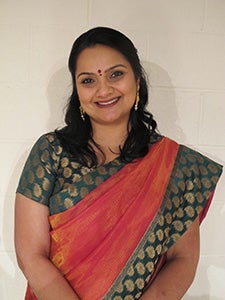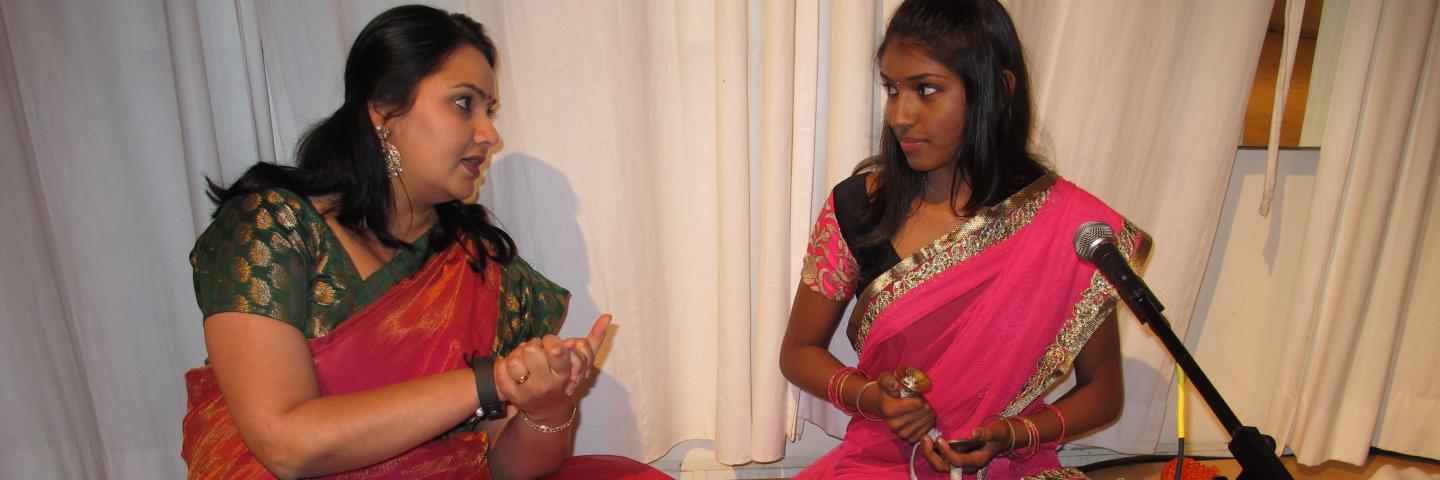 | Traditional skill/art/craft: Nattuvangam Years Awarded: 2016 |
ARTIST BIOGRAPHY
I grew up in India and immigrated to America in 1994. I moved to Oregon in 1995 when my husband was employed by Intel Corporation. I founded the Anjali School of Dance to provide training in the ancient Indian Classical Dance form of Bharatanatyam I am the recipient of the Performing Arts Fellowship in 2014 from the Regional Arts and Culture Council, the first Asian-American to receive this honor.
APPRENTICE BIOGRAPHY - Maya Jagannaathan 2016
Maya Jagannathan is a Bharatanatyam dancer who began the tradition at the age of five and commenced her training with her first solo performance (Arangetram) in 2014. Now she is interested in learning Nattuvangam which is the sounding of rhythmic syllables that are enhanced through the striking of cymbals. She performs regularly at various local community and cultural events where she feels a deep connection and appreciation for her cultural heritage and that she was able to learn and share this tradition. She plans to carry this tradition to the next generation through teaching and drawing awareness to the dying art form.
Q+A WITH THE MENTOR ARTIST
Describe your traditional art.
Body
The cultural tradition that I will be teaching is the art of playing the cymbals for a Bharatanatyam performance (Nattuvangam). A Bharatanatyam dance performance with a live orchestra comprises of a singer, a mridangist (an artist playing the South Indian Drum), a floutist, a violinist and/or a veena player. The orchestra is conducted by the artist playing the cymbals (Nattuvanar). This art form is taught only to students who have an ear for rhythm and a deep grounding in the basics of dance and music. The cymbals keep the dancer, the drummer and the rest of the orchestra at the same pace. The Nattuvanar is akin to a music conductor in a western symphony orchestra. Having learned this tradition from my own guru Chitra Visweswaran (a Presidential awardee in India), I seek to pass this onto the next generation of dancers so that they become the next generation of teachers and conductors of live orchestra.
How did you come to learn this tradition?
Body
I learned dance and nattuvangam from my Guru Chitra Visweswaran in India. She is an accomplished dancer, choreographer and the recipient of a Presidential Award for her contributions to dance in India. After 10 years of learning Bharatanatyam from her, she noticed my strong sense for rhythm and invited me to learn nattuvangam. I spent a whole year using the block and stick. Once my teacher was confident in my abilities and skills, she taught me how to use the metallic cymbals. Suddenly, one day for a performance, the person who regularly plays the cymbals was sick and I was asked to step in to play and conduct the orchestra. Since then I have gone on to playing the cymbals for over 200 performances in the past 25 years. I have also been invited to play the cymbals and conduct the orchestra for other Bharatanatyam dancers in the Portland area. Being a choreographer has helped me be a better Nattuvanar and conversely being a Nattuvanar has helped me be a better choreographer. Learning to play the cymbals, also requires the artist to know the words and meanings of the songs, the math calculations within the framework of each song and also to have an extremely strong sense of rhythm. Knowing all of these makes me a sensitive artist that can guide the dancer and the orchestra to bring out the best in each of them.
Why is this cultural tradition important to your community?
Body
Learning to play the cymbals is an art form that most immigrant dancers are taught as part of their curriculum in India. Unfortunately, I see this art form slowly dying because of the extensive use of prerecorded music for dance performances. With the availability of a multitude of ready-made sound tracks, dancers most often choreograph their dance to existing beats and emotions already portrayed in the music. Very rarely do dancers get the opportunity to innovate spontaneously and to customize the music. This is possible only with a live orchestra. Performing to live orchestras is rare in Portland because it is really hard to find orchestra members with the right skills to play for Indian Classical Dance, so we have had to fly in skilled orchestra members from other parts of the country for our performances. I am passionate about not letting that happen to the art form of playing cymbals I do not want a day to arrive when dancers have to fly in a Nattuvanar from another part of the country because we don't have anyone skilled in this art form locally. This is why it is crucial for me to pass on this art form to someone who will spend months learning all its nuances.
Experience/Honors
Body
